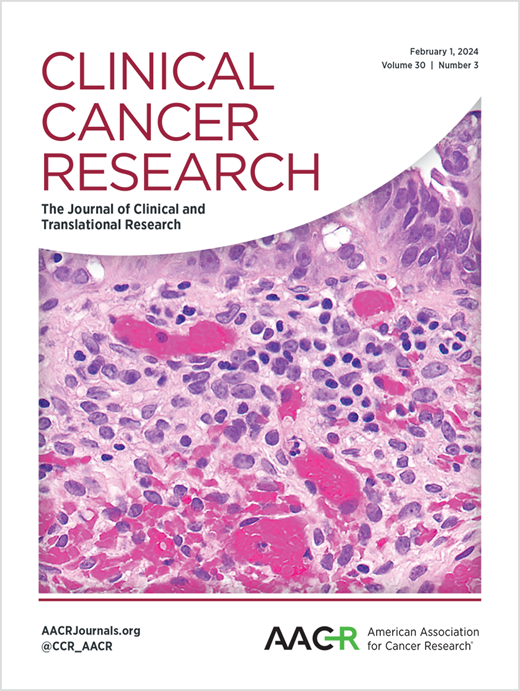CD27 agonist antibodies mediate clinical responses through intratumoral stimulation in B-cell malignancies: multicenter RiVa trial
IF 10.2
1区 医学
Q1 ONCOLOGY
引用次数: 0
Abstract
Purpose: Varlilumab is a CD27 agonist antibody, delivering a T-cell costimulation. Preclinical studies show agonistic CD27 antibodies can activate intratumoral T-cells to release chemokines and cytokines to augment macrophage-dependent tumor killing induced by CD20 antibodies, i.e. rituximab, in B-cell lymphoma. This clinical trial evaluated the safety and efficacy of rituximab and varlilumab in patients with previously treated B-cell non-Hodgkin lymphoma (B-NHL). Patient and Methods: This multicenter phase IIa trial recruited patients with relapsed or refractory CD20+ B-NHL. Patients were randomized to Arm A or B. All received rituximab on Day 1 of Cycles1-6, and varlilumab on Day 2 (Arm A) or Day 8 (Arm B) of Cycle 1, and Day 2 of Cycles 3 and 5. Tumor biopsies were collecting pre-treatment and on-treatment (after varlilumab in Arm A and before varlilumab in Arm B). The primary objective was to assess safety and anti-tumor activity. Results: Twenty-seven participants were evaluable, with modest overall response and disease control rates of 15.4% (4/27) and 38.8% (8/27), respectively. Intratumoral bulk RNA sequencing analysis demonstrated that adding varlilumab to rituximab enhanced CD4+ T-cell infiltration and increased T- and innate-cell signatures; inflamed tumor signatures were observed pre-treatment in responders. Single-cell analysis further showed that higher levels of CD27-expressing T and NK cells, along with activated γδ T-cell signatures, were associated with response, whereas CD27-expressing B cells correlated with non-response. Conclusions: Rituximab and varlilumab show modest activity. However, CD27 agonist antibodies may elicit meaningful anti-tumor responses when tumors express sufficient intratumoral targets and exhibit existing immune priming.CD27激动剂抗体通过肿瘤内刺激介导b细胞恶性肿瘤的临床反应:多中心RiVa试验
目的:Varlilumab是一种CD27激动剂抗体,提供t细胞共刺激。临床前研究表明,激动性CD27抗体可以激活瘤内t细胞释放趋化因子和细胞因子,以增强b细胞淋巴瘤中CD20抗体(即利妥昔单抗)诱导的巨噬细胞依赖性肿瘤杀伤。该临床试验评估了利妥昔单抗和伐利单抗治疗先前治疗过的b细胞非霍奇金淋巴瘤(B-NHL)患者的安全性和有效性。患者和方法:这项多中心IIa期试验招募了复发或难治性CD20+ B-NHL患者。患者被随机分到A组或B组。所有患者在第1-6周期的第1天接受利妥昔单抗治疗,在第1周期的第2天(A组)或第8天(B组)以及第3和第5周期的第2天接受伐利单抗治疗。肿瘤活检收集治疗前和治疗中(A组伐利单抗治疗后和B组伐利单抗治疗前)。主要目的是评估安全性和抗肿瘤活性。结果:27名参与者可评估,总体反应中等,疾病控制率分别为15.4%(4/27)和38.8%(8/27)。瘤内大体积RNA测序分析表明,将伐利单抗加入利妥昔单抗可增强CD4+ T细胞浸润,增加T细胞和先天细胞特征;治疗前在应答者中观察到炎症性肿瘤特征。单细胞分析进一步表明,高水平表达cd27的T细胞和NK细胞以及活化的γδ T细胞特征与应答相关,而表达cd27的B细胞与无应答相关。结论:利妥昔单抗和伐利单抗表现出适度的活性。然而,当肿瘤表达足够的肿瘤内靶点并表现出现有的免疫启动时,CD27激动剂抗体可能会引发有意义的抗肿瘤反应。
本文章由计算机程序翻译,如有差异,请以英文原文为准。
求助全文
约1分钟内获得全文
求助全文
来源期刊

Clinical Cancer Research
医学-肿瘤学
CiteScore
20.10
自引率
1.70%
发文量
1207
审稿时长
2.1 months
期刊介绍:
Clinical Cancer Research is a journal focusing on groundbreaking research in cancer, specifically in the areas where the laboratory and the clinic intersect. Our primary interest lies in clinical trials that investigate novel treatments, accompanied by research on pharmacology, molecular alterations, and biomarkers that can predict response or resistance to these treatments. Furthermore, we prioritize laboratory and animal studies that explore new drugs and targeted agents with the potential to advance to clinical trials. We also encourage research on targetable mechanisms of cancer development, progression, and metastasis.
 求助内容:
求助内容: 应助结果提醒方式:
应助结果提醒方式:


